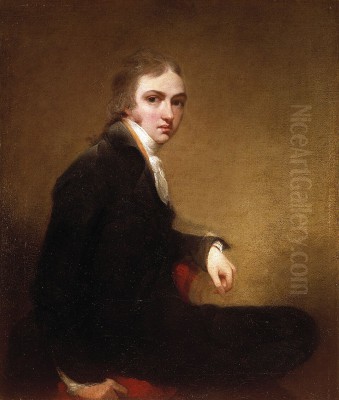
Sir Thomas Lawrence stands as one of the towering figures of British art, particularly renowned as the preeminent portrait painter of the Regency era. Born in 1769 and passing away in 1830, his life spanned a period of dramatic social, political, and cultural change in Britain and Europe. Lawrence captured the likenesses of the era's most prominent figures – from royalty and statesmen to military heroes and society beauties – with a distinctive blend of elegance, psychological depth, and technical brilliance. His rise from humble beginnings to become President of the Royal Academy and the favoured painter of King George IV is a testament to his extraordinary talent and ambition. This article delves into the life, career, style, and legacy of an artist who defined the face of an age.
A Prodigy's Ascent
Thomas Lawrence's journey began not in the hallowed halls of art academies, but in the bustling environment of coaching inns. He was born on April 13, 1769, in Bristol, the youngest surviving son of Thomas Lawrence Sr. and Lucy Read. His father was an innkeeper, first managing the White Lion in Bristol and later the Black Bear in Devizes, Wiltshire, a popular stop for travellers on the London-Bath road. It was in this public setting that the young Lawrence's remarkable talents first became apparent.
Even as a very young child, reportedly by the age of five, Lawrence possessed an uncanny ability to capture likenesses. His father, perhaps recognizing the potential draw for his inn, would often present his precocious son to guests. Young Thomas would sketch their profiles in pencil or pastel with astonishing speed and accuracy. Beyond his artistic gifts, he was also known for his ability to recite passages from Milton and Shakespeare, adding to his charm as a child prodigy. This early exposure to a diverse clientele likely honed his observational skills and his ability to interact with sitters, skills crucial for a future portraitist.
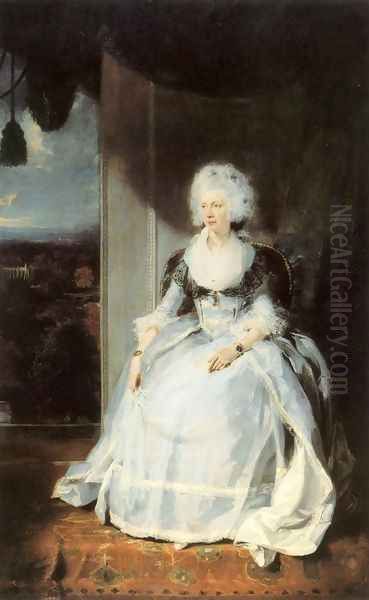
The family's fortunes took a downturn when Lawrence's father was declared bankrupt in 1779. This financial hardship, however, inadvertently propelled young Thomas's career forward. His burgeoning talent ceased to be merely a charming diversion; it became a vital source of income for the family. They moved to Bath, a fashionable spa town teeming with potential patrons among the wealthy visitors and residents. By the age of ten, Lawrence was already supporting his family through his pastel portraits.
Remarkably, Lawrence was largely self-taught during these formative years. While he may have received some informal guidance, his primary education came from studying works he could access, including Old Master paintings in local collections, and relentlessly practicing his craft. He developed an exceptional facility with pastels, achieving a sophistication far beyond his years. By the age of twelve, he had established his own studio in Bath and was gaining significant recognition, charging respectable fees for his portraits. His reputation as a boy wonder spread, attracting attention from influential figures who recognized his exceptional potential.
London Calling and Royal Patronage
The lure of London, the epicentre of the British art world, was irresistible for the ambitious young artist. In 1787, at the age of eighteen, Lawrence moved to the capital, initially lodging near the Strand. He briefly enrolled as a student at the prestigious Royal Academy Schools, gaining access to its life classes and collections. However, his time as a formal student was short-lived; his talent was already too developed, and commissions were beginning to materialize.
A pivotal figure in Lawrence's early London years was Sir Joshua Reynolds, the first President of the Royal Academy and the dominant force in British portraiture. Lawrence greatly admired Reynolds and sought his counsel. Reynolds recognized the young man's extraordinary ability, famously declaring after seeing one of Lawrence's works, "In you, sir, the world will expect to see accomplished what I have failed to achieve." While perhaps apocryphal, the sentiment reflects the high regard in which the aging master held the rising star. Reynolds's influence is visible in Lawrence's early oil paintings, particularly in the composition and handling of paint, though Lawrence would soon forge his own distinct path.
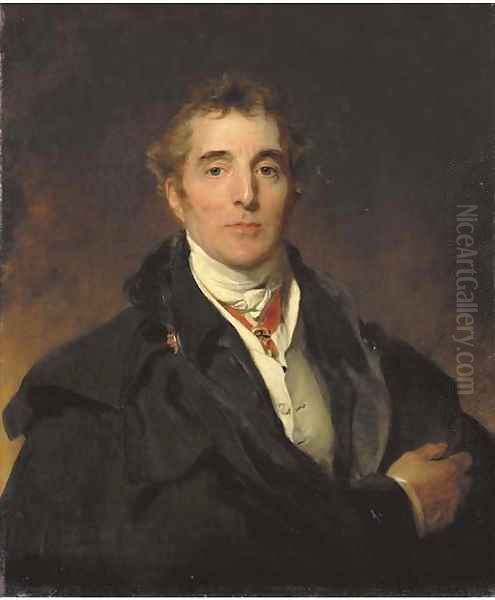
Lawrence quickly made his mark at the Royal Academy exhibitions. His submissions garnered attention and critical acclaim. A significant breakthrough came in 1789 when he exhibited a full-length portrait of the actress Elizabeth Farren, later Countess of Derby. This dazzling portrait, praised for its elegance, silvery tones, and fashionable sensibility, captivated the public and announced the arrival of a major new talent. It showcased Lawrence's ability to flatter his sitters while retaining a sense of individuality and vivacity.
Royal notice soon followed. In 1790, he was commissioned to paint Queen Charlotte, the wife of King George III. This prestigious commission, exhibited at the Royal Academy in 1790, solidified his position within the highest echelons of society. Although the Queen reportedly found the likeness unflattering initially, the portrait was widely admired for its technical skill and sophisticated portrayal. Following the death of Sir Joshua Reynolds in 1792, Lawrence was appointed Painter-in-Ordinary to King George III, a remarkable achievement for an artist still in his early twenties. This royal appointment secured his professional standing and opened doors to countless commissions from the aristocracy and political elite.
The Lawrence Style: Elegance and Drama
Thomas Lawrence developed a style that perfectly captured the spirit of the Regency period – an era characterized by elegance, romanticism, and a certain theatrical flair. While initially influenced by the grand manner of Reynolds and the lighter touch of Thomas Gainsborough, Lawrence forged a unique aesthetic that set him apart. His work is distinguished by its fluid, often bravura brushwork, rich and vibrant colour palettes, and a keen sensitivity to the personality and status of his sitters.
Lawrence possessed an exceptional ability to render textures, particularly the luxurious fabrics favoured by the fashionable elite of his day. Silks, satins, velvets, and furs are depicted with a convincing tactile quality, adding to the overall sense of opulence in his portraits. He combined this technical facility with a dramatic use of light and shadow (chiaroscuro), often highlighting the sitter's face and hands against darker, atmospheric backgrounds. This created a sense of immediacy and heightened the emotional impact of the portrait.
Compared to Reynolds, Lawrence's style often appears more dynamic and less formal. His figures frequently adopt elegant, sometimes slightly theatrical poses, conveying a sense of movement and vitality. He excelled at capturing not just a physical likeness but also the sitter's character, or at least the character they wished to project. His portraits often possess a psychological intensity, hinting at the sitter's inner life, whether it be the commanding presence of a statesman, the thoughtful gaze of an intellectual, or the alluring charm of a society beauty.
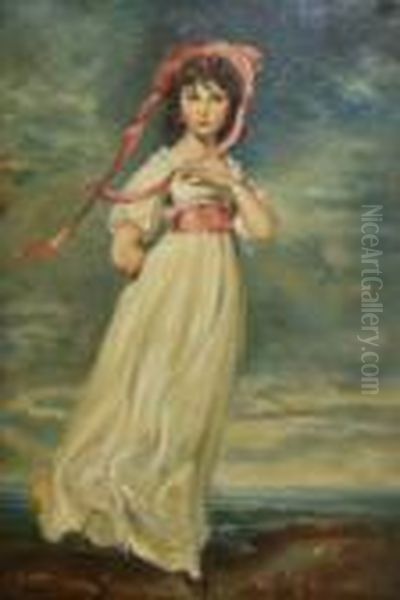
His contemporaries included other notable portraitists like John Hoppner, who was his main rival for royal favour for a time, and the Scottish master Sir Henry Raeburn, known for his robust and direct style. However, Lawrence's particular blend of fashionable elegance, technical virtuosity, and romantic sensibility gave his work a unique appeal that resonated deeply with the tastes of the era. He became the go-to painter for anyone who mattered, defining the visual identity of the British elite for decades. His approach marked a transition from the more restrained Georgian aesthetic towards the greater expressiveness associated with Romanticism.
Iconic Portraits: Capturing an Era
Sir Thomas Lawrence's vast output includes some of the most iconic images of the Regency period. His portraits serve as a visual chronicle of the era's leading personalities, reflecting the confidence, glamour, and sometimes the underlying anxieties of a nation navigating war and social change.
One of his most beloved, though perhaps atypical, works is the portrait of Charles William Lambton, often referred to as "The Red Boy" (painted 1825). Depicting the young son of Lord Durham seated on a rocky outcrop against a moonlit landscape, the painting is imbued with a profound sense of Romantic melancholy and innocence. Its rich colours, dramatic lighting, and the child's soulful gaze have made it enduringly popular. It showcases Lawrence's ability to move beyond formal portraiture into something more emotionally resonant.
His royal portraits are numerous and significant. The early portrait of Queen Charlotte (1789) established his royal connections. He later became the favoured painter of her son, the Prince Regent, who became King George IV in 1820. Lawrence painted George IV multiple times, perhaps most famously in his magnificent coronation robes (c. 1821), a dazzling display of royal pomp and painterly skill. These works cemented the image of the monarch for posterity.
Lawrence also excelled in portraying powerful men. His portrait of Arthur Wellesley, 1st Duke of Wellington (painted multiple times, notably for the Waterloo Chamber series), captures the "Iron Duke's" stern resolve and authority. Similarly, his portraits of statesmen like Lord Castlereagh and George Canning convey intelligence and political gravitas. These works often feature strong compositions and a focus on the sitter's determined expression.
He was equally adept at capturing the grace and allure of society women. The early portrait of Elizabeth Farren (1789) was a sensation. Later works, such as the portrait of Sarah Barrett Moulton: "Pinkie" (1794), although sometimes debated regarding its attribution but strongly associated with his style and era, or the elegant depiction of Catherine Grey, Lady Manners (1794), showcase his ability to convey feminine charm, fashionable attire, and individual personality. He painted countless members of the aristocracy, creating images that defined beauty and status for the age.

Beyond the British elite, Lawrence's later career saw him paint major European figures, including Pope Pius VII (1819) and the Austrian statesman Prince Klemens von Metternich (1819), further demonstrating the international reach of his reputation and skill. His sitters also included fellow artists, such as the American-born painter Benjamin West, who succeeded Reynolds as President of the Royal Academy before Lawrence himself held the post, and the visionary artist Henry Fuseli. Each portrait, whether of king or child, general or actress, reveals Lawrence's remarkable ability to adapt his style to the individual while maintaining his signature elegance and technical mastery.
President of the Royal Academy
Lawrence's ascent within the formal structure of the British art world paralleled his success as a society portraitist. He was elected an Associate of the Royal Academy (ARA) in 1791, a remarkably swift progression for a young artist. Full membership as a Royal Academician (RA) followed in 1794. These elections signified the recognition of his peers and cemented his place within the artistic establishment.
Throughout his career, Lawrence remained actively involved with the Royal Academy, regularly exhibiting his works and participating in its governance. His studio became a hub, and his influence extended to younger artists. His technical brilliance and fashionable success made him a figure to emulate, though few could match his innate talent.
The culmination of his institutional career came in 1820. Following the death of Benjamin West, Sir Thomas Lawrence – having been knighted by the Prince Regent in 1815 in recognition of his services to art and his portraits of the Allied leaders – was unanimously elected President of the Royal Academy (PRA). This was the highest honour available to a British artist, previously held by giants like Reynolds and West.
As President, Lawrence presided over the Academy's exhibitions and schools, delivered discourses (though fewer and perhaps less theoretically profound than Reynolds's), and represented the institution at official functions. His presidency coincided with a period of continued prestige for the Academy. He was known for his gracious manner and diplomatic skills, which were valuable in navigating the sometimes-complex relationships between artists, patrons, and the state. His own international fame undoubtedly added lustre to the position. He held the presidency until his death in 1830, guiding the institution through a decade that saw the emergence of new talents like J.M.W. Turner and John Constable, whose landscape paintings represented a different direction in British art but coexisted with Lawrence's portraiture dominance during his tenure.
European Acclaim and Diplomatic Canvases
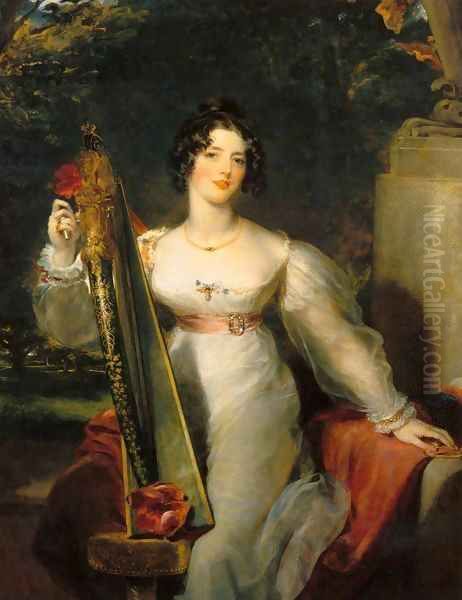
While Lawrence built his primary reputation in Britain, his fame extended across Europe, particularly in the later stages of his career. This international renown was significantly boosted by a major commission from the Prince Regent (later George IV). Following the defeat of Napoleon Bonaparte, the Prince Regent conceived a grand project to commemorate the Allied victory: a series of portraits of the key sovereigns, statesmen, and military leaders responsible for the triumph. Sir Thomas Lawrence was chosen for this prestigious task.
Starting in 1818, Lawrence embarked on travels to the continent to paint these influential figures from life. His journey took him first to Aix-la-Chapelle, where a congress was being held, and then on to Vienna and Rome. This diplomatic and artistic mission placed him at the heart of European power politics, granting him access to emperors, kings, popes, and ministers.
In Vienna, he painted figures such as Emperor Francis I of Austria and the influential statesman Prince Metternich. In Rome, his sitters included the venerable Pope Pius VII and Cardinal Consalvi. These portraits, destined for the Waterloo Chamber at Windsor Castle, are among Lawrence's most impressive achievements. He managed to capture the distinct personalities and the weight of historical responsibility carried by these men, all while maintaining his characteristic elegance and technical polish. The portrait of Pope Pius VII, in particular, is often cited as a masterpiece of psychological insight and painterly skill.
This commission not only resulted in a unique historical gallery but also cemented Lawrence's reputation as Europe's leading portrait painter. He was fêted wherever he went, receiving honours and further commissions. His style, while distinctly British, resonated with continental tastes, offering a blend of formality and romantic sensibility. His international standing placed him in the company of leading European artists of the day, such as the Neoclassical masters Jacques-Louis David and Jean-Auguste-Dominique Ingres in France, though Lawrence's approach offered a warmer, more painterly alternative to French Neoclassicism. The Waterloo Chamber portraits remain a powerful testament to both the Allied victory and Lawrence's exceptional talent.
Legacy and Critical Reception
Sir Thomas Lawrence died suddenly in London on January 7, 1830. He was buried with great ceremony in St Paul's Cathedral, a mark of the high esteem in which he was held. His death marked the end of an era in British portraiture. He left behind a vast body of work, numbering hundreds of portraits, which provide an unparalleled visual record of the Regency elite.

His influence on subsequent portrait painting was significant, particularly in the early Victorian period. Artists like Sir Francis Grant and Franz Xaver Winterhalter (though German, he worked extensively in Britain) show traces of Lawrence's elegant compositions and flattering style. However, the rise of photography later in the 19th century would fundamentally change the role and nature of painted portraiture.
Lawrence's critical reception has fluctuated over time. During his lifetime and immediately after his death, he was lauded for his technical brilliance, his ability to capture a likeness, and the sheer glamour of his work. However, later critics, particularly those favouring the perceived realism and moral seriousness of other schools, sometimes found his work superficial or overly theatrical. Accusations of flattery and a certain repetitive quality in his poses occasionally surfaced. It's also true that the demands of his enormous practice sometimes led to uneven quality, with studio assistants likely playing a role in completing less critical parts of his canvases.
Despite these criticisms, Lawrence's reputation as a master technician and a defining artist of his age remains secure. His best works demonstrate an undeniable virtuosity in handling paint, a sophisticated understanding of colour and light, and a remarkable ability to convey both the outward appearance and the inner presence of his sitters. He successfully navigated the demands of patronage, creating images that satisfied his clients while also achieving high artistic merit. Modern scholarship tends to appreciate his work within its historical context, recognizing his role in developing the Romantic portrait and his exceptional skill in capturing the specific atmosphere of the Regency period. His paintings continue to be admired in galleries worldwide, valued for their aesthetic appeal and historical significance.
Conclusion
Sir Thomas Lawrence dominated British portraiture for nearly four decades. From his beginnings as a child prodigy in an inn to his presidency of the Royal Academy and his role as painter to royalty and European leaders, his career was one of extraordinary success. He possessed a rare combination of innate artistic talent, ambition, charm, and an intuitive understanding of his era's tastes. His portraits defined the visual identity of the Regency, capturing its elegance, confidence, and romantic spirit.
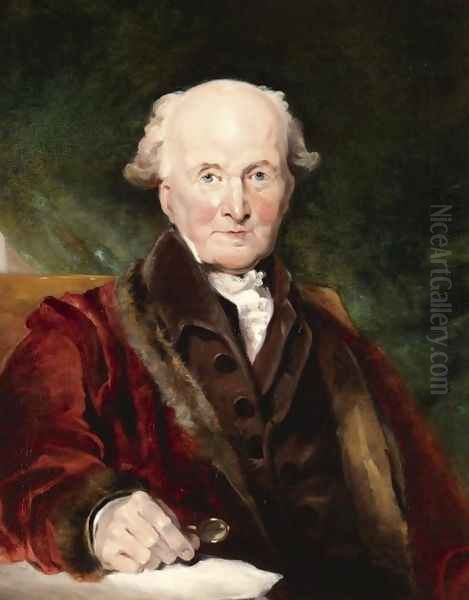
With his fluid brushwork, rich colours, dramatic lighting, and insightful characterization, Lawrence created a style that was both highly personal and perfectly attuned to his time. He inherited the mantle of Reynolds and Gainsborough but adapted the tradition of grand manner portraiture to a new sensibility. While sometimes criticized for a perceived lack of depth or an excess of theatricality, his finest works – like the poignant Charles William Lambton, the regal George IV in Coronation Robes, or the penetrating Pope Pius VII – remain masterpieces of the genre. As a chronicler of a fascinating age and a painter of exceptional skill, Sir Thomas Lawrence holds an enduring place in the history of British and European art.